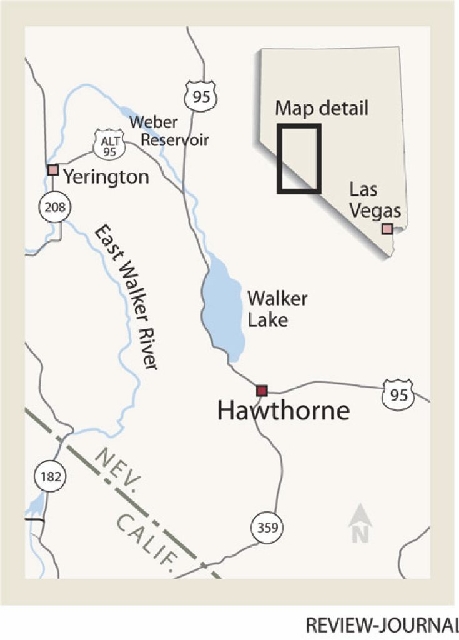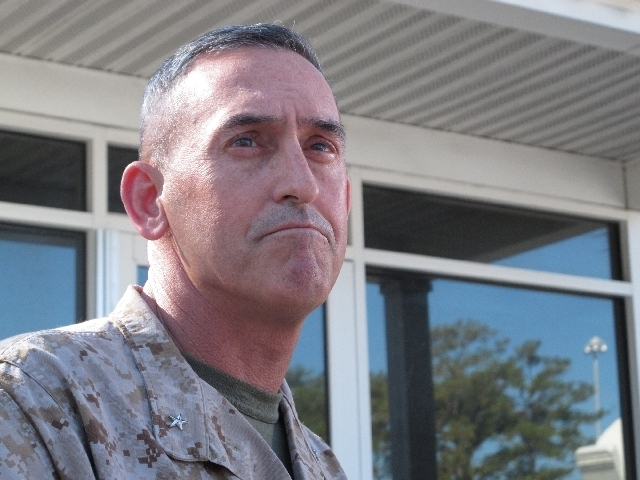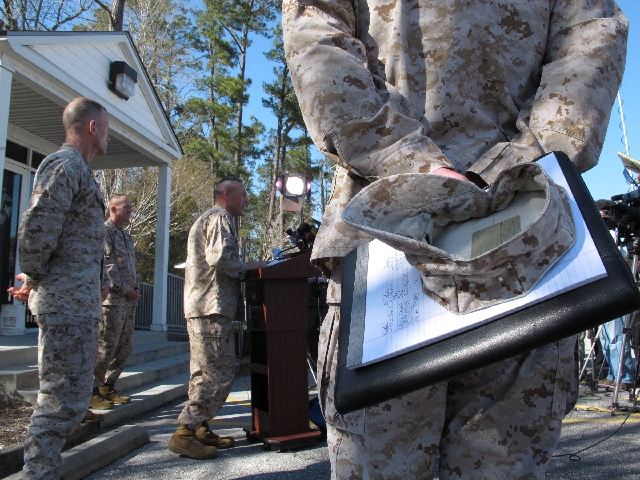Seven killed in explosion during training at Hawthorne Army Depot





Seven Marines were killed and several others injured Monday night in an explosion during a training exercise at the Hawthorne Army Depot in Northern Nevada.
A 60 mm mortar exploded during a live-fire training exercise about 10 p.m. as Marines from the 2nd Marine Division based at Camp Lejeune, N.C., were firing it.
The mortar round exploded in its firing tube, officials said at a news conference Tuesday afternoon. The cause of the accident remains under investigation.
The Marine Corps issued an indefinite moratorium on firing all 60 mm mortars worldwide until an investigation clears the weapon and ammunition as safe.
The 60 mm mortar is a weapon that traditionally requires two or three Marines to operate, but it is common during training for others to observe nearby. There are several types of projectiles, but it’s unclear what type was being used.
The circumstances and moratorium indicate the ammunition might be suspect, according to Steve Lowery, a retired Marine major from Las Vegas and Vietnam War Navy Cross recipient who is familiar with mortar training.
“In all my career, I never heard of them stopping mortars because of an accident,” Lowery said. “Something went awry and this one behaved differently.
“If the round went off as it came out of the tube, that means defective ammunition. You typically can’t have anything wrong with the tube. It’s such a reliable weapon, and it typically doesn’t misbehave in this fashion,” said Lowery, 66, whose valor award stemmed from his actions in 1969.
Eight men younger than 30 were taken to Renown Regional Medical Center in Reno.
One serviceman was declared dead at the hospital.
As of Tuesday evening, three were listed in serious condition, three were in fair condition, and one had been treated and released.
One of the injured servicemen is a U.S. Navy corpsman. The Marines do not have their own medical personnel but are assigned Navy corpsmen.
Their injuries include penetration wounds, fractures and vascular injuries, hospital emergency doctor Michael Morkin said.
Some of the injured Marines he treated were conscious and “knew something happened but didn’t know what.”
Morkin said he is “fairly confident” that one of the most seriously injured Marines wouldn’t have survived had it not been for the response of a Careflight medical helicopter to the remote site.
Morkin said the Marines mostly suffered blunt-force trauma from shrapnel.
“They’re injuries of varying severity … to varying parts of the body. They’re complicated injuries to deal with,” he said.
Zip Upham, Naval Air Station Fallon public affairs officer, said the search and rescue team was on alert but did not launch. He said Navy and Marine personnel are assisting family members to travel to Reno to see the injured Marines.
The identities of those killed will be released 24 hours after next-of-kin notification, officials said in a statement from the 2nd Marine Expeditionary Force at Camp Lejeune.
“We send our prayers and condolences to the families of Marines involved in this tragic incident. We remain focused on ensuring that they are supported through this difficult time,” said Maj. Gen. Raymond C. Fox in a statement. “We mourn their loss, and it is with heavy hearts we remember their courage and sacrifice.”
Hawthorne, population 3,000, is about 320 miles northwest of Las Vegas and 135 miles southeast of Reno. The depot stores and disposes of ammunition, is spread over 226 square miles and is one of the largest in the world.
It’s not unusual for military personnel to use the depot for more than storage.
The Marine Corps Mountain Warfare Training Center is about 60 miles west in Pickel Meadow, Calif., and Marines often travel to Hawthorne for live-fire training, according to a Marine Corps publication.
The Mountain Warfare Training Center has 46,000 acres, but the land is managed by the U.S. Forest Service under the Department of Agriculture.
“The land is open to public use, and military operations understandably cannot adversely impact civilian use or the environment,” the Marine Corps Gazette wrote. Hawthorne “includes training support infrastructure and high-angle fire ranges, as well as a company-sized urban complex and combat outposts.”
From Hawthorne, Marines can travel 60 miles north to Naval Air Station Fallon, which includes a battalion-sized urban training facility.
Monday night’s accident happened in an area about six miles south of Hawthorne known locally as “Old Bomb.”
Master Sgt. J.D. Cress at Camp Lejeune said the Marine Corps has trained troops at the depot for a “very long time.”
“There’s a variety of training that takes place there. It’s not narrowly focused.”
Cress said the desert mimics the terrain and weather in Afghanistan.
“As best as possible, we try to have realistic training environments, which would include desert training,” he said.
One Marine from a Reno unit said the depot training area has a mock town and forward operating base.
The Hawthorne Army Depot is a popular training site for other branches of the military, said another person familiar with the location who spoke on condition of anonymity.
Earlier this year, Navy SEALs trained at Hawthorne, conducting mountain maneuvers and dropping into Walker Lake, which adjoins the depot.
“There is a ton of training and a lot of secret stuff going on out there,” he said. “Hawthorne is a very big deal. And they’re really good at what they do out there. That’s why this accident is so shocking. They’ve gone so long without any kind of incident.”
The depot opened in 1930 in isolated Hawthorne after an earlier explosion in an ammunition depot in New Jersey in which 21 people were killed.
Because of its isolation, Hawthorne was considered a safer place to store ammunition. Ammunition is stored in rows of 3,000 igloo-like bunkers stretching miles in all directions.
Even today the depot is isolated.
During World War II, the ammunition depot stored most of the bombs and ammunition used in the war in the Pacific. More than 5,000 people worked at the depot during the war, and the town of Babbit was created adjacent to the base.
Babbit faded into history soon after the war.
In 2006, the Defense Department moved to close the depot, leading to an effort by Nevada’s congressional delegation to keep it open because the city of Hawthorne depends on it.
Monday’s deaths prompted swift condolences from Nevada’s governor and congressional delegation.
“My thoughts are with those who were injured,” said U.S. Senate Majority Leader Harry Reid, D-Nev., on the floor of the Senate. “My heart goes out to the families of those who lost their lives. And my sympathies are with their fellow Marines, who are also grieving this loss.”
Gov. Brian Sandoval echoed Reid’s comments.
“The men and women who work and train there put service ahead of self each and every day. Kathleen and I wish to extend our deepest sympathies to those killed and their families. Our thoughts and prayers are with those who have been injured and we pray for their speedy recovery.”
Republican U.S. Rep. Joe Heck said the tragedy underscores the dangers facing troops at home or overseas.
“I will continue to watch this situation closely, and my staff and I stand ready to assist in any way we can in the wake of this horrible event,” Heck said in a statement.
Reid also cited the accident in a call for Congress to reverse spending cuts.
“These men and women — our Marines — were training at Hawthorne, and with the sequester it is going to cut this stuff back,” Reid said. “This sequester should go away. It is just not appropriate that our military can’t train and do the maintenance necessary.”
Rep. Steven Horsford, D-Nev., said he knew of no evidence that corners might have been cut on safety at Hawthorne because of the sequester.
He said, “The investigation will be forthcoming and I’m sure we will get all the facts at the appropriate time.”
At Nellis Air Force Base, where a throng of leaders and community supporters were celebrating Tuesday’s arrival of the first F-35 Joint Strike Fighter jets, U.S. Air Force Maj. Gen. Jeffrey G. Lofgren said the tragedy put a damper on the morning.
“It is a sad day anytime we lose lives out there,” Lofgren, Warfare Center commander, said after the arrival ceremony.
“Our thoughts and prayers go out to those families. It makes it more important for us, and more poignant for us about the mission here at Nellis and what we’re focused on. We need to stay focused on that if we’re going to be successful in the future protecting those Marines.”
Review-Journal reporters Keith Rogers, Laura Myers, Steve Tetreault and Peter Urban contributed to this report. Contact reporter Mike Blasky at mblasky@reviewjournal.com or 702-383-0283. Contact Capital Bureau Chief Ed Vogel at evogel@reviewjournal.com or 775-687-3901.
Related Story
Deaths shock quiet military town; last incident in 1971
M224 60 mm
Lightweight Mortar
■ Length: 40 inches
■ Weight: 46.5 pounds
■ Bore diameter: 60 mm
■ Maximum effective range: 2.17 miles
■ Rates of fire:
— Maximum: 30 rounds/minute
— Sustained: 20 rounds/minute
■ Cost: $10,658
■ Features: A smooth bore, muzzle loading, high-angle-of-fire weapon. A mortar shell is dropped into the cannon tube, where a firing pin at the base hits a primer in the bottom of the shell. Expanding gas propels the shell out of the tube.
■ Mission: Support light infantry rifle companies, Rangers and special operations units with indirect fire. The short minimum range makes it well-suited for close protective fire against an assaulting enemy, for block-to-block fighting in cities, and combat over close terrain with restricted visibility.
SOURCE: United States Marine Corps












